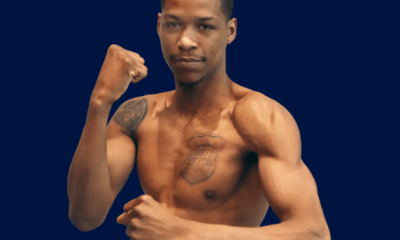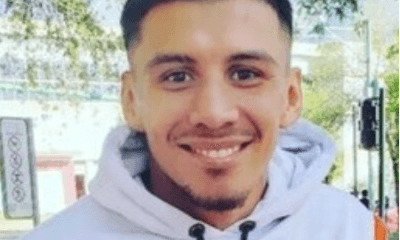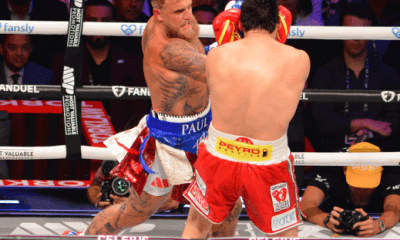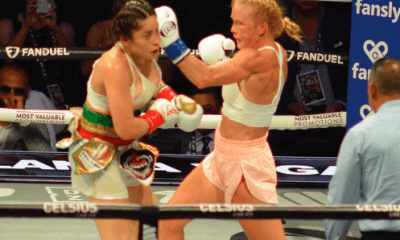Featured Articles
How Good Was Ill-Fated Luther McCarty, the Best of the ‘White Hopes’?
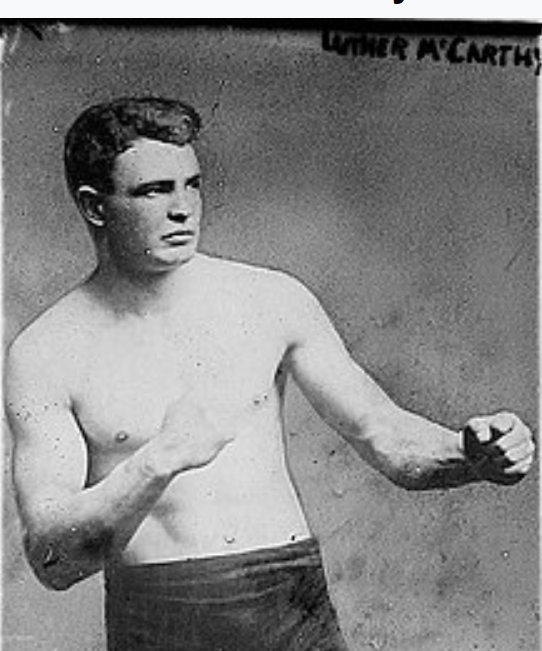
Luther McCarty “is the embodiment of all that goes to make a ring champion, the possessor of speed, hitting ability, an aptitude for learning the finer points of the fistic sport and the gamest man to ever lace on a glove.” So read a widely circulated newspaper story that made the rounds in June of 1912.
The author of this puff piece (it bore no byline) was undoubtedly a reporter on the take. In this era, the sports sections of newspapers were full of stories that blurred the distinction between honest reporting and hyperbole. That being said, there was a growing sentiment among the cognoscenti that Luther McCarty had the best chance of all the Caucasian heavyweights of knocking Jack Johnson off his pedestal. Johnson’s title reign was then in its fourth year.
Eleven months after the story ran, it became a moot point. On May 24, 1913, 110 years ago this month, Luther McCarty dropped dead in the opening round of a fight with Arthur Pelkey in Calgary, Alberta, Canada. The decedent was only 21 years old.
If stories about McCarty are true, he packed a lot of living into his short time on this earth. Before finding his niche as a prizefighter, McCarty — who in old photos bears an uncanny resemblance to the renowned University of Nebraska football coach Tom Osborne when both were of the same age — was at various times a seaman, a lumberjack, a coal miner, a cowboy, and a stunt-rider whose act was sponsored by a tobacco company.
McCarty was born in Nebraska, near Lincoln according to some sources and near McCook according to others (the towns are 225 miles apart). He spent a good portion of his youth in Clay Center, Kansas, and had his first documented fight in Culbertson, Montana, a ranching community. When he became a well-known sports personality, both Sidney, Ohio, and Springfield, Missouri claimed him.
McCarty’s father was literally, not figuratively, a snake oil salesman. Billing himself as Dr. White Eagles, he roamed the Midwest in a gaily covered wagon from which he sold snake oil, touted as a cure for all ills. His wife, who traveled with him, reportedly died from a rattlesnake bite in about 1910 while staying in a hotel in Peoria, Illinois. The snake, a prop, escaped from its box which was kept in their room. (Mrs. White Eagles was presumably McCarty’s step-mother. One of the first stories about him said that his mother was an Irish immigrant who died when Luther was a mere toddler as she was giving birth to a stillborn child.)
It was in Springfield, the Queen City of the Ozarks, where McCarty came to the fore. His conquest of Oklahoma railroad engineer Carl Morris on May 3, 2012, was a national news story. Carrying 235 pounds on his six-foot-four frame, Morris, the “Sapulpa Giant,” was two inches taller and 20 pounds heavier than McCarty who knocked him out in the sixth frame.
McCarty spent the next five months campaigning back east with mixed results. Veteran slugger Jim Stewart spoiled his New York debut, winning a 10-round newspaper decision at Madison Square Garden.
The opposite coast proved far more salubrious. McCarty’s push to regain lost luster began on Oct. 12, 2012, in San Francisco with a smashing second-round knockout of Al Kaufman. Two months later, on Dec. 10, he was in Vernon, California (a town in Los Angeles County), looking across the ring at Fireman Jim Flynn.
This fight was framed as an “eliminator” with the winner going on to fight Al Palzer for the White Heavyweight Championship of the World.
Jim Flynn, called Fireman Jim because he had worked on steam-powered locomotives shoveling coal into a furnace, was a battle-tested veteran. Six years earlier, he had given Tommy Burns a tough tussle in a failed bid for Burns’ world heavyweight title. Burns stopped him in the 15th-round. More recently, he had challenged Jack Johnson, losing by disqualification in the first and ultimately only heavyweight title fight ever staged in New Mexico.
The late money was on Fireman Jim who went to post a small favorite. Those that bet against McCarty had egg in their face when the referee halted the massacre in the 16th round. Flynn “was beaten to an almost unrecognizable mass,” wrote a ringside reporter. “His face was puffed until it was almost unrecognizable and his eyes were swollen shut. His seconds had to assist him from the ring, while McCarty walked out fresh as a daisy.”
Al Palzer, an Iowa farm boy, had been fighting for only two years, but he was a strapping lad, carrying 227 pounds on a six-foot-four frame, and, in the vernacular of a gambling man, he came from a good barn. His manager, Tom O’Rourke, had built George Dixon from scratch into a fighter still recognized in many quarters today as the greatest bantamweight of all time.
Al Palzer’s signature win had come against the highly-touted British import Bombardier Billy Wells, the heavyweight champion of England. Knocked groggy in the first two rounds, Palzer got off the deck to stop the Bombardier in the third frame.
Once again McCarty entered the ring a slight underdog and, once again, he made a mockery of the odds. Palzer rarely took a backward step but was repeatedly beaten to the punch. The referee halted the mismatch in the 18th round, whereupon Palzer “reeled drunkenly to his corner and cried like a child.”
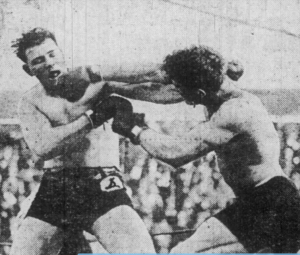
In those days, the best measure of a mega-fight was the number of telegraphers at ringside. There were plenty that afternoon at promoter Tom McCarey’s arena in Vernon; round-by-round reports were flashed to newspaper offices and poolrooms around the country. In faraway Pittsburgh, where the New Years Day fight started at 6 pm local time, the Pittsburgh Press (“The People’s Paper”) hired a megaphone man to read the round-by-round bulletins to the crowd standing outside in the cold. Other newspapers did likewise.
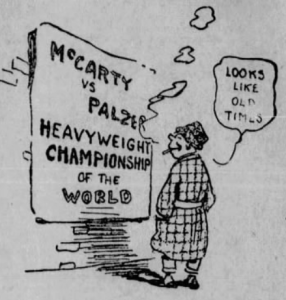
McCarty had two more fights before his ill-fated bout with Arthur Pelkey, winning newspaper decisions over Fireman Jim Flynn and Frank Moran, in Philadelphia and New York respectively. Then it was on to Calgary to defend his belt against journeyman Pelkey in a bout staged in a 7,000-seat wooden arena built by Tommy Burns who had taken up residence in Calgary as his career was winding down.
The bout was barely 90 seconds old when Pelkey hit McCarty with a blow that landed just above the heart and McCarty collapsed to the canvas. It was a pedestrian punch – a straight jab in a feeling-out round – but Luther McCarty had drawn his last breath. The general feeling was that the punch had aggravated an old neck injury that McCarty had suffered when he fell off a horse, a reckoning that absolved the principals of manslaughter. “The same thing might have happened to anyone walking down the street or eating dinner,” said Tommy Burns.
It was an earie scene made more haunting in memory by interconnected events.
Before the opening bell, the pastor of Calgary’s St. Augustine’s Anglican church was brought into the ring to say a few words. “He told [the combatants] not to forget in their chase of fame that they had a creator and to prepare to meet him.” As McCarty lay prone on the canvas before the stupefied gathering, a ghostly ray of sunlight came through an opening in the structure and shrouded McCarty’s lifeless body. Adding to Tommy Burns’ anguish, on the night of May 25, the day after the fight, a fire of uncertain origin burned his arena to the ground.
An era usually lasts generations and doesn’t come into focus until a considerable amount of time has elapsed. Interestingly, boxing writers were using the phrase White Hope Era when the “era” was just getting started and it was a short-lived phase that effectively ended in Arthur Pelkey’s next fight when he was knocked out by journeyman Gunboat Smith. Pelkey’s vaunted punch, wrote a reporter, was merely a suspicion.
(True, Jess Willard was dubbed a White Hope, but by 1915, when he de-throned Jack Johnson, he wasn’t tagged as such by the promoters as the label had become a term of derision. A little-known fact is that there were a number of so-called White Hope Tournaments during the late 1930s in the U.S. and Canada, but these promotions, conventionally restricted to men with no prior boxing experience — men off the street, but some ringers always slipped in — were tournaments in name only. Precursors of the “Tough Man” competitions popular in the 1980s and 1990s, they died out when Joe Louis came to be widely admired for more than just his fistic prowess.)
Newspaper reports leave the impression that Luther McCarty was a bigamist. Several days after he died it was reported that his widow, who he met in Ohio, was working in a hash house in Fargo, North Dakota. However, his inheritance went to another woman, a lady in Springfield, Missouri, with whom he had a young daughter. And whatever his faults, it appears that Luther, despite his tender age, was no fool with his money. His estate included $8,200 (roughly $250,000 in today’s dollars) on deposit in a Los Angeles bank and four oceanfront lots on a beach near Boston.
Now let’s cut to the chase and address the question we asked in the title of this article: How good was Luther McCarty, by which we mean how would he have fared if thrust against a prime Jack Johnson?
I think the answer is plain. He would have been in way over his head.
It goes without saying that Johnson was more fluid, but he also packed a harder punch. McCarty tattooed Fireman Jim Flynn and Al Palzer with every punch in his repertoire round after round after round, but both men were still standing when the bouts were terminated. Also, “strength of schedule” counts for something and McCarty’s fellow White Hopes were a motley lot. The craze to find someone to upend Johnson flooded the sport with lumbering mediocrities whose exertions would have been better deployed doing chores around the farm or unloading freight.
To call Luther McCarty a cut above the others, no matter how true, is damning him with faint praise. He was, however, a colorful character in one of the most interesting phases in American boxing history.
Arne K. Lang’s third boxing book, titled “George Dixon, Terry McGovern and the Culture of Boxing in America, 1890-1910,” rolled off the press in September. Published by McFarland, the book can be ordered directly from the publisher or via Amazon.
To comment on this story in the Fight Forum CLICK HERE
-

 Featured Articles3 weeks ago
Featured Articles3 weeks agoAvila Perspective, Chap. 330: Matchroom in New York plus the Latest on Canelo-Crawford
-

 Featured Articles2 weeks ago
Featured Articles2 weeks agoVito Mielnicki Jr Whitewashes Kamil Gardzielik Before the Home Folks in Newark
-

 Featured Articles4 weeks ago
Featured Articles4 weeks agoAvila Perspective, Chap 329: Pacquiao is Back, Fabio in England and More
-

 Featured Articles3 weeks ago
Featured Articles3 weeks agoOpetaia and Nakatani Crush Overmatched Foes, Capping Off a Wild Boxing Weekend
-

 Featured Articles2 weeks ago
Featured Articles2 weeks agoCatching Up with Clay Moyle Who Talks About His Massive Collection of Boxing Books
-

 Featured Articles4 weeks ago
Featured Articles4 weeks agoFabio Wardley Comes from Behind to KO Justis Huni
-

 Featured Articles1 week ago
Featured Articles1 week agoMore Medals for Hawaii’s Patricio Family at the USA Boxing Summer Festival
-

 Featured Articles4 weeks ago
Featured Articles4 weeks agoDelving into ‘Hoopla’ with Notes on Books by George Plimpton and Joyce Carol Oates

